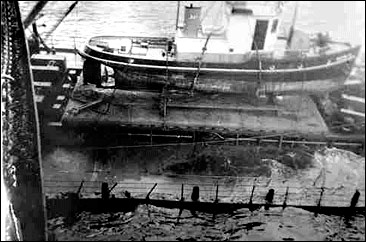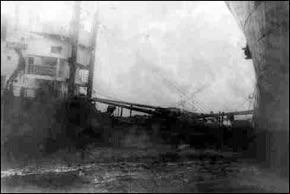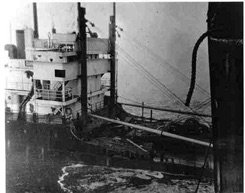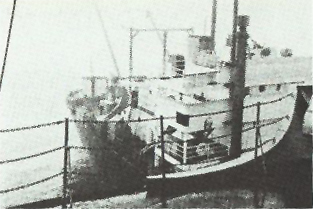M/S Diamond Knot
The M/S Diamond Knot was a C1-M-AV1 type vessel with a length of 338.5 feet, a beam of 50 feet, depth of 29 feet, draft of 18 feet, and a gross tonnage of 3,805. She was a single screw carrier (1,750 horsepower) that could cruise at 11 knots. Originally constructed during WWII, like the C1-M-AV1 vessel Kukui (WAK 186),

the Knot was designed for short coastal runs in the Pacific. She was owned by the U.S. Maritime Commission under a bareboat charter to the Alaska Steamship Co.

Going outbound from Seattle, The Fenn Victory rode high in the water with only 200 tons of cargo. As the Victory came within 6 miles of Port Angeles at around 1:15 a.m. the Diamond Knot and the Fenn Victory collided. The Fenn Victory rammed her so hard, it became locked 14 feet into the Diamond Knot’s starboard side. Any further aft and several crew members would surely have been killed.
The Coast Guard picked up distress calls and sent out the Mathilda Foss and Foss No. 21 (tugs), along with the Salvage Chieftain, and even a Royal Canadian Naval craft to try and help. Circling the two dueling giants the captains of the tugs tried to figure out a way to save the ships. Burning equipment was then brought on site to try and release the death grip. At this point the Knot’s main deck was awash,



and her crosstrees on the mainmast were tangled with the Fenn’s forecastle.
After several hours the two ships were separated. The Fenn Victory chugged on her own steam towards port while the doomed Diamond Knot with 23 feet of water in No. 3 hold, 20 feet in No. 2 hold and 10 feet in No. 1 hold went under tow, stern first, towards the protective waters off Crescent Bay. It was here, they believed, they could beach her and save the precious cargo. But the currents at the entrance of Crescent Bay are some of the strongest in the Strait, and this made the tugs already hard work near impossible. At 8:45 a.m. there was a noticeable jerk in the towline. She was sinking deeper. At 8:55 the towboat men were forced to cut the tow lines. The Diamond Knot was going down.

Evacuated from his dying ship, Captain C.N. Goodwin and his crew watched as she rolled over on her side, and disappeared from the surface. At 8:57 a.m. the Diamond Knot went to her grave in 135 feet of water.
The Fireman’s Fund Insurance Company and the Sea Insurance Company made payments totaling $3,395,391.55 for cargo, $16,000 was paid out for the cannery tender lashed on the Knot’s deck, and $12,000 to the crew for personal items lost. The sinking put in place one of the largest cargo losses on the west coast.
With having to write all those large checks, the insurance companies considered salvage to compensate. Walter Martignoni, a San Francisco based salvage master, was contacted for the job. Helping him was Captain Loring Hyde (salvage expert) and divers Walter McCray, and Fred Divine. The barge Diver III was anchored over the wreck and the work commenced. First discussions involved the use of magnets to recover the cans, or stevedoring methods (unloading by hand). Both were rejected. The decided plan was to use 2 twelve-inch siphon pipes that would suck out the salmon and fish oil.
First to be recovered out of tanks successfully was the fish oil totaling $22,000 worth. Next was the salmon. Divers burnt holes through the No. 2 hold where they found 2,000,000 cans of salvageable salmon. With one hose pushing air on the salmon crates, ripping them open, the other sucked the cans aboard the waiting barge. They continued with No. 3 hold and so on until the Diamond Knot’s port side was 90% cut away.
October 29th, 77 day’s after the Diamond Knot sank the last accessible can was salvaged. Out of 7,407,168 cans of salmon, 5,744,496 cans were brought to the surface. The salmon was tested, inspected, and repacked for delivery. Of the 5,744,496 salvaged cans, 4,179,360 cans were restored to “sound commodity.”
The accident between the Diamond Knot and the Fenn Victory was found to be “mutual fault.” But sadly Captain Joseph Gaidsick, the Master of the Fenn Victory, apparently ashamed over the blemish on his record, hanged himself in the cabin of his ship.

Courtesy USCG Archives #5316

All photos of the Knot; Courtesy of Puget Sound Maritime Historical Society



-
-Home
